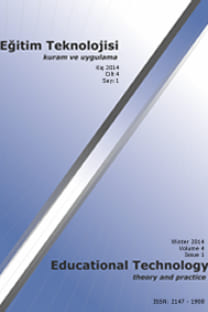Çevrimiçi Öğrenme Ortamlarında Öğrenci Bağlılık Ölçeği'nin Türkçe Uyarlaması: Geçerlik ve Güvenirlik Çalışması
THE TURKISH ADAPTATION OF STUDENT'S ENGAGEMENTS SCALE INONLINE LEARNING ENVIRONMENT: A STUDY OF VALIDITY AND RELIABILITY
___
- Badge, J., L., Saundersb, F., W. ve Canna, A., J. (2012). Beyond marks: new tools to visualise student engagement via social networks. Research in Learning Technology, 20(1).
- Bouta, H., Retails, S. ve Paraskeva, F. (2012). Utilising a collaborative macro-script to enhance student engagement: A mixed method study in a 3D virtual environment. Computers & Education, 58(1), 501-517.
- Büyüköztürk, Ş. (2007). Veri Analizi El Kitabı. Ankara: PegemA Yayıncılık.
- Carini, R. M., Kuh, G. D. ve Klein, S. P. (2006). Student engagement and student learning: Testing the linkages. Research in Higher Education, 47 (1), 1-32.
- Chen, P. D., Kuh, G. D. ve Gonyea, R. M. (2008). Learning at a distance: Engaged or not?. Innovate Journal of Online Education, 4 (3).
- Finn, J.D. (1993). Student engagement and student at risk. Washington,DC: National Center For Education Statistics.
- Finn, J.D. ve Rock, D.A. (1997). Academic success among students at risk for school failure. Journal of Applied Psychology, 82, 221-261.
- Fredericks, J. A., Blumenfeld, P. C. ve Paris, A. H. (2004). School engagement: Potential of the concept, state of the evidence. Review of Educational Research, 74, 59 - 109.
- Halttunen, K. ve Jarvelin, K. (2005). Assessing learning outcomes in two information retrieval learning environments. Information Processing and Management, 41, 949-972.
- Junco, R. (2012). The relationship between frequency of Facebook use, participation in Facebook activities, and student engagement. Computers & Education, 58(1), 162-171.
- Junco, R., Heiberger, G. ve Loken, E. (2011). The effect of Twitter on college student engagement and grades. Journal of Computer Assisted Learning, 27(2), 119-132.
- Kline, R. B. (1998). Principles and Practice of Structural Equation Modeling, New York: The Guilford Press.
- Klassen, R., M., Yerdelen, S. & Durksen, T. (2013). Measuring Teacher Engagement: Development of the Engaged Teachers Scale (ETS). Frontline Learning Research, 2, 33-52.
- Krause, K. ve Coates, H. (2008). Students' engagement in first-year university. Assessment and Evaluation in Higher Education, 33(5), 493-505.
- Kuh G. D. (2009) What student affairs professionals need to know about student engagement. Journal of College Student Development, 50, 683-706.
- Mazer, J., P. (2013). Validity of the Student Interest and Engagement Scales: Associations with Student Learning Outcomes. Communication Studies, 64(2), 125-140.
- Miyazoe, T. ve Anderson, T. (2010). Learning outcomes and students' perceptions of online writing: Simultaneous implementation of a forum, blog, andwiki in an EFL blended learning setting. System, 38, 185-199.
- Schermelleh-Engel, K., Moosbrugger, H. ve Müller, H. (2003). Evaluating the Fit of Structural Equation Models: Tests of Significance and Descriptive Goodness-of-Fit Measures. Methods of Psychological Research Online, 8(2), 23-74.
- Stipek, D. (2002). Good instruction is motivating. In A. Wigfield & J. Eccles (Eds.), Development of achievement motivation. San Diego, CA: Academic Press.
- Stovall, I. (2003). Engagement and Online Learning. UIS Community of Practice for E-Learning. 03.04.2014 tarihinde http://otel.uis.edu/copel/EngagementandOnlineLearning.ppt adresinden erişilmiştir.
- Sun, J. C.-Y. ve Rueda, R. (2012). Situational interest, computer self-efficacy and self-regulation: Their impact on student engagement in distance education. British Journal of Educational Technology, 43(2), 191-204.
- Tabachnick, B. G. ve Fidel, L. S. (2001) Using Multivariate Statistics (4th edition). Boston: Allyn and Bacon.
- Thompson, S. (2005). Engaging students with school life. Youth Studies Australia, 24(1).
- Willms, J.D. (2003). Student Engagement at School: a sense of belonging and participation: Results from PISA 2000. Organisation for Economic Co-operation and Development. 09.10.2014 tarihinde http://www.oecd.org/edu/school/programmeforinternationalstudentassessmentpisa/33689437.pdf adresinden erişilmiştir.
- ISSN: 2147-1908
- Yayın Aralığı: Yılda 2 Sayı
- Başlangıç: 2011
- Yayıncı: Tolga Güyer
Büşra ÖZMEN, Fatma Kübra ÇELEN, Yasemin USLUEL KOÇAK
Yasemin Koçak Usluel, Büşra Özmen, Fatma Çelen
Ebru KILIÇ ÇAKMAK, Volkan KUKUL, Ekmel ÇETİN, Burcu BERİKAN, Bülent KANDEMİR, Bahattin PAMUKÇU, Necati TAŞKIN, Mehmet MARANGOZ
İNTERNETE YÖNELİK EPİSTEMOLOJİK İNANÇ ÖLÇEĞİNİN UYARLAMA ÇALIŞMASI
Ebru KILIÇ ÇAKMAK, Yasemin KOÇAK USLUEL, F GİZEM KARAOĞLAN YILMAZ
ÖĞRETMEN ADAYLARININ BİREYSEL YENİLİKÇİLİK ÖZELLİKLERİNİN FARKLI DEĞİŞKENLER AÇISINDAN İNCELENMESİ *
Yusuf Ziya OLPAK, Agâh Tuğrul KORUCU
İnternete Yönelik Epistemolojik İnanç Ölçeğinin Uyarlama Çalışması
Ebru KILIÇ ÇAKMAK, F. Gizem Karaoğlan Yılmaz, Ramazan YILMAZ
Işıl KABAKÇI YURDAKUL, Özden ŞAHİN İZMİRLİ, Özgür ÖRÜN
Esin ERGÜN, Yasemin Koçak Usluel
Ebru KILIÇ ÇAKMAK, Volkan KUKUL, Ekmel ÇETİN, Burcu BERİKAN, Bülent KANDEMİR, Bahattin PAMUKÇU, Necati TAŞKIN, Mehmet MARANGOZ
